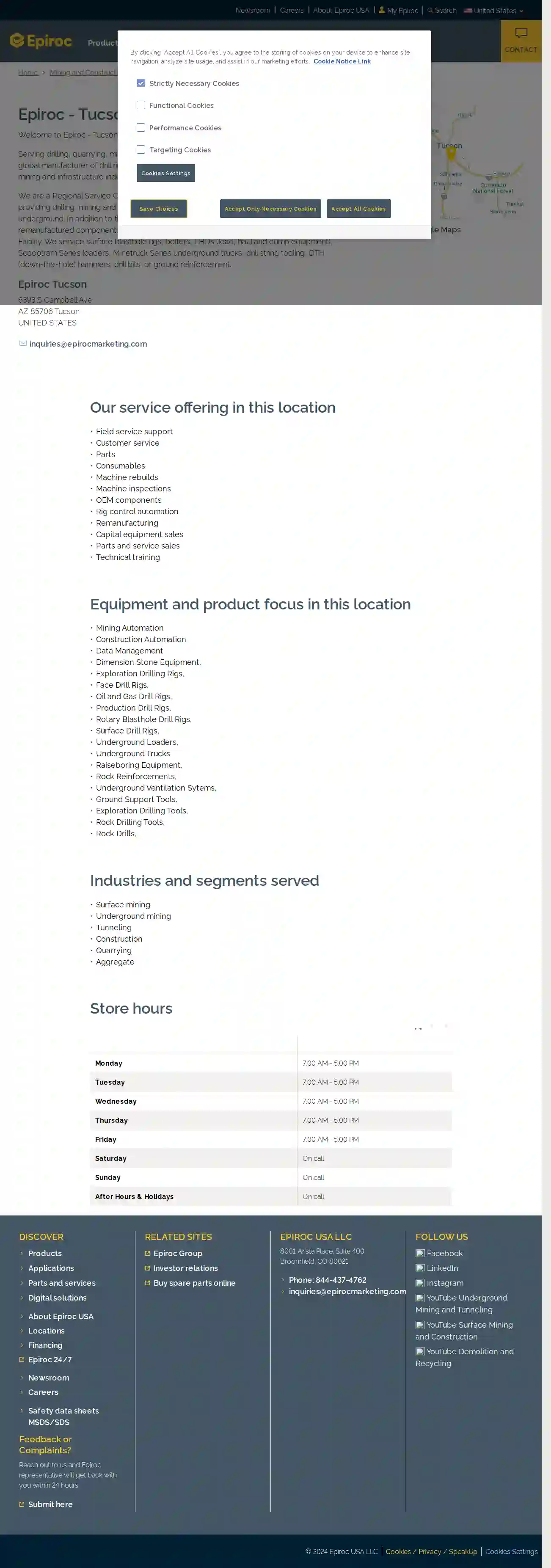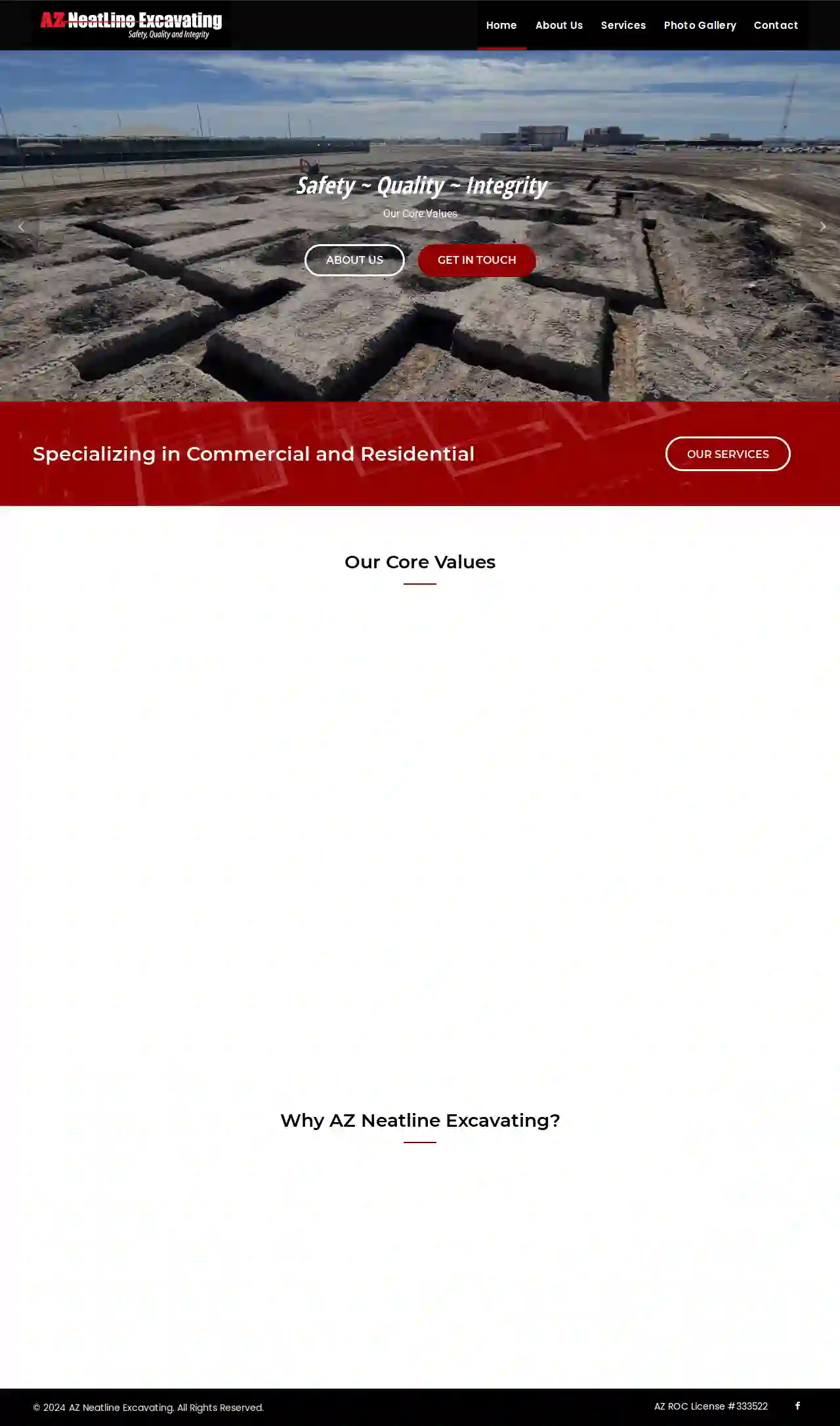Excavation Contractors Tucson Mountains
Find the best Excavation Contractor in Tucson Mountains
Get multiple Excavation Company Near Me quotes for your project today! Compare profiles, reviews, accreditations, portfolio, etc... and choose the best service.

Rummel Construction Inc Shop
4.880 reviews1000 S. Ellsworth Rd., Mesa, 85283, USFounded on Integrity. Since our start in 1996, Rummel Construction, Inc. has been providing top-quality heavy civil construction services in the Southwest. Backed by our experienced, committed personnel, and advanced technological capabilities, we deliver safe and innovative solutions to our clients. Our Work Rummel is proud to serve a broad range of markets in the heavy civil industry. With over 300 pieces of equipment, Rummel can support a variety of project needs. Our model equipment fleet is consistently maintained and updated to enable excellent service and a quality product. Delivery Methods In addition to the traditional hard bid delivery method, Rummel also pursues projects through the following methods: CMAR - Construction Manager at Risk JOC - Job Order Contract DB - Design Build
- Services
- Why Us?
- Gallery
Get Quote
Goodwillie Earthwerks
52 reviewsTucson, USOver 2 Decades of Excavation Experience Goodwillie Earthwerks has nearly two decades of experience in excavation, demolition, clearing and hauling. We offer a wide array of services from basic grading and drainage solutions to utility infrastructure design and install. At Goodwillie Earthwerks, we take great pride in our reputation in quality work and highly satisfied customers. Why Choose Our Excavating Contractor? We gladly go the extra mile to ensure your 100% satisfaction! Goodwillie Earthwerks, Inc is a locally owned and operated excavating company in Tucson, AZ. We are your top choice for excavating contractors! If you're looking for a professional excavating contractor in the Oro Valley and Tucson, AZ area who specializes in excavation needs and services, look no further than Goodwillie Earthwerks. Our excavating company can handle everything for you! We've been providing long-term care and attention to detail when you need work done on your commercial property for many years. We strive to provide quality and professional workmanship at competitive prices for all types of excavation work. You can rely on our team of experienced excavating professionals to be there for you from the first consultation to the big reveal! Goodwillie Earthwerks is a group of highly trained excavating professionals who pay attention to the smallest details and strive for excellence. Using our services can improve the appearance of your commercial or residential property and increase its value. Your commercial and residential properties will look great when you choose to work with Goodwillie Earthwerks's excavating contractor! When you give us a call, you will be connected directly to our owner, so you can expect immediate attention to your inquiry. So, don’t wait. Call us today!
- Services
- Why Us?
- Testimonials
- Gallery
Get Quote
JC Contracting
57 reviews7234 E Shoeman Ln Suite 1, Scottsdale, 85251, USWho we are At JC Contracting, we are a dedicated team of skilled professionals specializing in high-quality concrete and stucco services. With five experienced crews and a supportive small office staff, we work together to deliver exceptional craftsmanship and personalized service. Founded on the principles of quality, integrity, and customer satisfaction, we strive to exceed expectations on every project, big or small. Our commitment to excellence and attention to detail set us apart as a trusted partner for all your concrete and stucco needs. On Budget, On time. Every time.
- Services
- Why Us?
- Gallery
Get Quote
A&E Excavation
51 reviews216 Dishman Lane, Bowling Green, 42101, USFrom The Ground Up A&E Excavation and A&E Trucking offers an extensive range of services encompassing all facets, from excavating footers to providing topsoil, ensuring the project's successful conclusion. Who We Are A&E Trucking and Excavation, a company based in Bowling Green, KY, prides itself on being both owned and operated by Veterans. Our commitment lies in executing every task with the utmost professionalism. We eagerly anticipate the opportunity to assist you in bringing your commercial and industrial projects to fruition. Reach out to us today for further information. Excavation Pros at setting up building pads, parking lots, footings, utilities, septic systems, and leveling the playing field! Trucking We offer a range of materials including topsoil, fill dirt, and various types of stone. Additionally, the company specializes in custom hauling and haul-off services. Pride In Our Community Our core objective revolves around supporting businesses in actualizing their commercial and industrial ventures. Our organization is dedicated to delivering vital services to our growing community. We are enthusiastic about furthering our involvement as our community flourishes. From Site Prep To Topsoil We possess the expertise to manage projects of various scales. Whether you are at the inception or culmination of your project, our support remains unwavering. Initiate contact with us to explore how we can contribute to realizing your project aspirations. Commercial & Industrial Ensuring your satisfaction with the level of professionalism maintained at each job site is of utmost importance. Contact us for a free consultation. Multi-Residential Site Prep Initiate your subdivision project successfully by leveraging the expertise of A&E professionals. Contact us today! Commercial Site Prep A&E is proficient in preparing construction sites to facilitate seamless operations. Topsoil If your project requires topsoil, please reach out to A&E Trucking to arrange for a prompt delivery. Contact us! Stone Stone for your upcoming project? Our supply encompasses a diverse array of stone types. Commercial & Industrials Let's Create Something Great We approach every project with confidence and enthusiasm, ready to collaborate with each and every customer. Our primary objective is to provide exceptional service, regardless of the scale of the project. Engage us in your upcoming development; we are eager to combine efforts and create remarkable outcomes together. Let us embark on this exciting journey side by side! Backfill and Recompacting We specialize in precise backfilling, ensuring proper compaction from start to finish. A&E Excavating is renowned for its unmatched industry expertise and a vast clientele who are consistently satisfied, positioning us as a reputable leader in grading, excavation, recompacting, and similar services.
- Services
- Why Us?
- Gallery
Get Quote
Epiroc - Tucson, AZ
4.47 reviewsTucson, USContact Epiroc Epiroc is a leading productivity partner for the mining and infrastructure industries. We offer a wide range of products and services, including drill rigs, loaders and trucks, excavator attachments, rock drilling tools, ground support, ventilation systems, and automation solutions.
- Services
- Why Us?
Get Quote
AZ NeatLine Excavating
4.58 reviewsPO Box 868, Waddell, 85355, USAbout AZ Neatline Excavating We specialize in all types of construction and project needs. We take on a variety of projects from small residential projects that may require correcting drainage issues on your property or digging in your new swimming pool to large commercial projects such as installing water mains in city streets or plumbing for industrial buildings. With our knowledge & experience, there isn’t a job too small or too big that we can’t take on. AZ Neatline takes pride in everything we do, no matter the size or demands of your project we treat them all as a partnership and are there every step of the way. Craig Birzer, Owner & Founder Craig Birzer grew up in the country in a small town in Wyoming. Growing up ranching taught Craig what hard work truly is, and gave him the work ethic he has today. Craig’s been in the industry for over 25 years. Craig started as a laborer in the industry and worked his way up through every field level gaining a substantial amount of knowledge that has helped him throughout his career and still does to this day. After becoming a foreman, then a project superintendent running a variety of projects from small to multimillion dollar jobs, Craig became a general superintendent being responsible for over 110 field personnel and multiple projects daily. Craig then entered the office side of construction doing project management work, engineering work and estimating. In 2021, during the COVID pandemic, Craig saw the need for people who needed help getting projects completed, with a lack of manpower and experience. He decided to pursue his long life dream and open up AZ Neatline Excavating and provide people with quality service and experience they deserve.
- Services
- Why Us?
- Our Team
- Gallery
Get Quote
Westate Construction Inc
52 reviews4850 Lafayette Road, Hopkinsville, 42240, USOur Story Westate Construction, Inc., is a Disadvantaged Business Enterprise (DBE), certified by the Kentucky Transportation Cabinet and is Pre Qualified in both Kentucky and Tennessee. Our company has the team and equipment to perform any earthwork, concrete and drainage work necessary on any project. We are fully bonded, insured, and qualified to perform work in grade and drain, edge drain, clearing and grubbing, bituminous concrete paving, traffic control, ditching and shouldering, bridge approaches, DGA base and cement construction, curb and gutter, sidewalks, entrance pavement, paved ditch and culverts, demolition and buildings and related construction. Westate Construction, Inc. has provided professional, quality, proven services since 1985 to the Kentucky Transportation Cabinet, the United States Government, DOD and other agencies. Who We Are We are a Disadvantaged Business Enterprise (DBE), certified by the Kentucky Transportation Cabinet Where We Serve We are certified by the Kentucky Transportation Cabinet and Pre Qualified in both Kentucky and Tennessee When We Began We began providing professional quality services in 1985
- Services
- Why Us?
- Gallery
Get Quote
Rustic Oaks Landscaping
11 reviews3410 N. Main St., East Peoria, 61611, USWelcome to Rustic Oaks Lawn and Landscaping Rustic Oaks Lawn and Landscaping provides Peoria, Tazwell, and Woodford counties with professional landscape design, installation, and maintenance. Rustic Oaks services both Commercial and Residential clients. Rustic Oaks Lawn and Landscaping is proud to be an A+ Better Business Bureau Accredited company. We provide full service grounds maintenance for all Spring, Summer, Fall, and Winter. Our office staff would be happy to schedule a meeting with one of our experienced and knowledgeable Project Managers to discuss your landscaping needs and dreams. We love to say, “Your neighbors will love what we have done with your lawn”… and they will. We find that once we start to create in a neighborhood, it isn’t long before another homeowner is exploring their own outdoor living capabilities with us. Our experienced Landscape/Hardscape/Aquascape designers are ready, willing and able to assist with any of your service needs, big or small. We have the skills and tools needed to effectively perform any job that they are asked to perform. When you want quality landscaping services at affordable prices then rely on Rustic Oaks Lawn and Landscaping. We don’t just offer quality landscaping services but we also work with our customers to offer them customizable services. You will always get the landscaping services that you need from us so you never have to look any further. We offer you our service guarantee.
- Services
- Why Us?
- Gallery
Get Quote
Septon Development Group, Inc
4.616 reviews9545 E Doubletree Ranch Rd., Scottsdale, 85258, USSepton Development Group, Inc. is a construction management company based in Scottsdale, Arizona. We have been serving the Arizona and Western United States markets since 2000. Our commitment is to our clients and building quality products. We believe our future is realized by focusing on long-term performance and client satisfaction rather than short-term profit. Fundamental to this has been the awareness that our relationship-based approach to project delivery is what ultimately defines us and is the differentiator for Septon amongst our competitors. We're always looking to improve our customer's experience, so we ask them how we're doing and what we can do better. When we start a project, we learn what their specific goals are and check in regularly during the project lifecycle to see if we are still on target for achieving those goals. Securing our future by advancing the success of our clients. Your construction project is about you and your organization. It's about us learning your vision and how we can support it and bring it to life. Your vision inspires and drives us to continually improve and take our construction services to new levels, finding better tools, creative ideas, and solutions that push boundaries and lead to better projects. That's why ingenuity has always been the foundation upon which we build. We place state-of-the-art software, processes, and controls at the center of all our work, giving us the ability to anticipate obstacles and improve productivity. This means a better building experience, and a better building. People make the difference Septon Development believes our people are our most valuable asset, combining their unique qualities and talents to increase the value of our team. Since the formation of Septon in 2000, we have built a management team that has well over 60 years of experience in the construction industry. Our commitment to the client and building a quality product has led Septon Development Group to become a well-respected and thriving company in every market we serve.
- Services
- Why Us?
- Our Team
- Gallery
Get Quote
Landwehr Construction Inc
3.916 reviews851 60th St S, St. Cloud, 56301, USLandwehr Construction: A Legacy of Excellence Since 1895 Landwehr Construction, Inc. is a fifth-generation family-owned contractor with a rich history spanning over 125 years. We've built a reputation for outstanding customer service and unwavering commitment to excellence. Our dedication to safety is paramount, forming the cornerstone of our work environment and culture. With three strategically located offices in the Midwest - St. Cloud and Chaska, Minnesota, and a division in Sioux Falls, South Dakota - we're equipped to handle projects of any size and complexity. Our expansive fleet of state-of-the-art equipment, coupled with our commitment to innovation, ensures we meet future demands while upholding our legacy of excellence and reliability. Landwehr is your one-stop contractor, offering a comprehensive range of services, including: Crane & Rigging Demolition Environmental Remediation Highway Heavy Machinery Moving Renewable Energy Sitework & Utilities Wetland Specialty Our team comprises highly trained and skilled professionals, many of whom are certified in their respective fields. We take pride in our employees' longevity and their commitment to building their careers with Landwehr. Our experienced project management team ensures your project is completed to the highest standards, giving you peace of mind. Safety is not just a priority at Landwehr; it's a core value. Our employees are rigorously trained to work safely without compromising production or quality. We maintain an enviable worker's compensation mod ratio consistently below 1.00 and have a zero-tolerance policy for accidents. Our active safety committee, comprised of employees from all levels of the company, spearheads safety education, promotion, incentive programs, and program reviews. We have dedicated employees trained in hazardous and asbestos material detection, OSHA 10 safe practices, ground tank removal and supervision, erosion and sediment control management, first aid/CPR, and demolition landfill practices.
- Services
- Why Us?
- Gallery
Get Quote
Over 22,076+ Excavation Companies onboarded
Our excavation pros operate in Tucson Mountains & surroundings!
ExcavationHQ has curated and vetted Top Excavation Companies in Tucson Mountains. Find a top & trustworthy pro today.
Frequently Asked Questions About Excavation Contractors
- Spring and Fall: Often considered favorable due to moderate temperatures and drier soil conditions.
- Summer: Can be suitable, but hot weather can make working conditions challenging and might require additional measures (shade, hydration) for workers.
- Winter: Excavation in winter can be more difficult due to frozen ground, snow, and potential delays caused by inclement weather. It might also require specialized equipment or techniques.
- Clear the Area: Remove any obstacles, including vehicles, outdoor furniture, landscaping features, or structures, from the excavation zone and surrounding area.
- Mark Existing Features: Identify and mark underground utilities, septic tanks, sprinkler systems, or other buried elements you want to protect.
- Protect Landscaping: Use tarps or fencing to shield trees, shrubs, gardens, or other landscaping elements from damage.
- Provide Access: Ensure the excavation contractor has clear access to the work area, including gates wide enough for equipment.
- Discuss Logistics: Coordinate with the contractor regarding parking arrangements, material delivery, and any special instructions or concerns you might have.
- Experience: Choose contractors with a proven track record and years of experience in excavation projects similar to yours.
- Licensing and Insurance: Verify that they are properly licensed to operate in your area and carry adequate insurance to protect you from liability in case of accidents or damage.
- Equipment and Resources: Ensure they have the necessary equipment and resources to handle your project efficiently and safely.
- Positive Reviews and References: Check online reviews and testimonials from previous customers. Request references and contact them to inquire about their experience with the contractor.
- Professionalism: Opt for a company that communicates clearly, provides detailed and transparent estimates, and has a responsive and courteous team.
- Sloped Property: Your property has a significant slope, making it prone to soil erosion or landslides.
- Creating Usable Space: You want to level off a sloped area to create a flat surface for patios, gardens, or other outdoor spaces.
- Preventing Damage: Erosion is threatening existing structures, driveways, or walkways.
- Landscaping Features: You're incorporating tiered gardens, raised beds, or other landscaping elements requiring soil retention.
What is the best time of year for excavation?
How do I prepare my property for excavation?
How do I find a good excavation contractor?
How do I know if I need a retaining wall?
What is the best time of year for excavation?
- Spring and Fall: Often considered favorable due to moderate temperatures and drier soil conditions.
- Summer: Can be suitable, but hot weather can make working conditions challenging and might require additional measures (shade, hydration) for workers.
- Winter: Excavation in winter can be more difficult due to frozen ground, snow, and potential delays caused by inclement weather. It might also require specialized equipment or techniques.
How do I prepare my property for excavation?
- Clear the Area: Remove any obstacles, including vehicles, outdoor furniture, landscaping features, or structures, from the excavation zone and surrounding area.
- Mark Existing Features: Identify and mark underground utilities, septic tanks, sprinkler systems, or other buried elements you want to protect.
- Protect Landscaping: Use tarps or fencing to shield trees, shrubs, gardens, or other landscaping elements from damage.
- Provide Access: Ensure the excavation contractor has clear access to the work area, including gates wide enough for equipment.
- Discuss Logistics: Coordinate with the contractor regarding parking arrangements, material delivery, and any special instructions or concerns you might have.
How do I find a good excavation contractor?
- Experience: Choose contractors with a proven track record and years of experience in excavation projects similar to yours.
- Licensing and Insurance: Verify that they are properly licensed to operate in your area and carry adequate insurance to protect you from liability in case of accidents or damage.
- Equipment and Resources: Ensure they have the necessary equipment and resources to handle your project efficiently and safely.
- Positive Reviews and References: Check online reviews and testimonials from previous customers. Request references and contact them to inquire about their experience with the contractor.
- Professionalism: Opt for a company that communicates clearly, provides detailed and transparent estimates, and has a responsive and courteous team.
How do I know if I need a retaining wall?
- Sloped Property: Your property has a significant slope, making it prone to soil erosion or landslides.
- Creating Usable Space: You want to level off a sloped area to create a flat surface for patios, gardens, or other outdoor spaces.
- Preventing Damage: Erosion is threatening existing structures, driveways, or walkways.
- Landscaping Features: You're incorporating tiered gardens, raised beds, or other landscaping elements requiring soil retention.